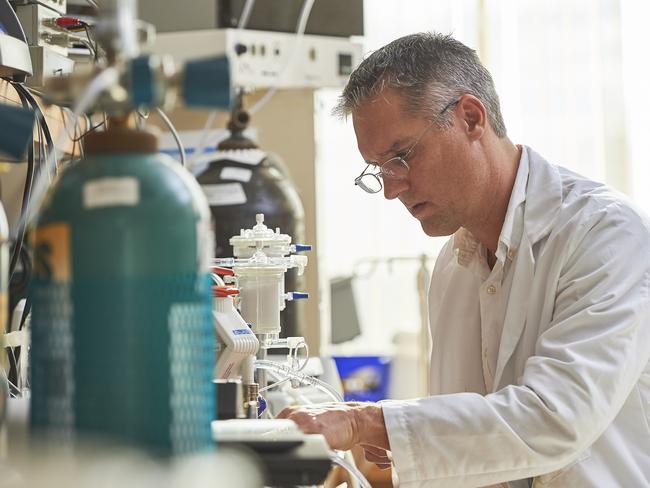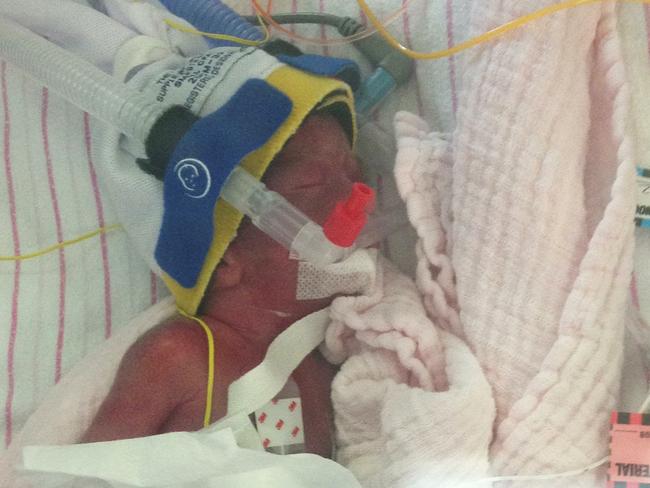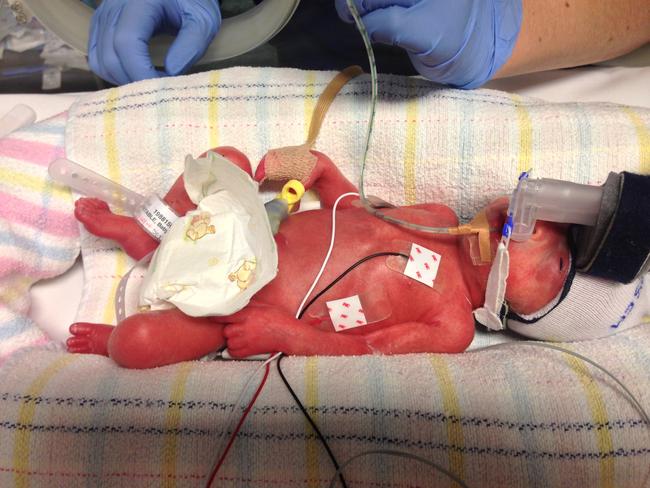Australian Doctor Marcus Davey gives premature babies hope with creation of an artificial womb
IT started with beer piping and midnight trips to the Bunnings of America. Now an Aussie doctor has created an artificial womb to help premature babies.
Babies
Don't miss out on the headlines from Babies. Followed categories will be added to My News.
IT started with midnight trips to the Bunnings of America — Home Depot — and gluing together pieces of piping normally used to make home brewed beer.
And while it may seem like science fiction, Australian doctor Marcus Davey says the development of a viable artificial womb is one of the most exciting medical developments in a long time.
Melbourne-born Dr Davey describes himself as the “Macgyver” of the US-based project, announced last month, that is giving new hope to premature babies.
He was the doctor responsible for building and developing a device that has now proven to grow lambs in a plastic-bag type womb, filled with synthetic amniotic fluid for a month.
Researchers from the Children’s Hospital of Philadelphia placed foetal lambs equivalent to 22-23 weeks human gestation in a biobag equipped with a pumpless membrane oxygenator — a placenta-like system to send nutrients, blood and oxygen through the foetus’ body via the baby’s heart.

The sealed, sterile environment inside the system is insulated from variations in temperature, pressure and light, and particularly from hazardous infections.
It managed to keep some of the animals healthy for up to 670 hours, or 28 days. Several lambs born via the system are now happy and living on a farm in Pennsylvania.
And the goal is to begin human trials within two to three years. In eight to ten years it is hoped the device will be live across all neonatal units around the world, including Australia.
If you watch a video of the womb in action, it is somewhat confronting.
A lamb — whose foetal physiology is similar to humans — inside a custom-built plastic bag full of synthetic amniotic fluid, eyes closed and moving about as you expect it to in-utero.
You get a birds-eye view into life inside the womb. And if your baby was inside a locked bag of fluid it would likely be even more confronting.

Dr Davey says the device would be used for babies born between the 24-28 week gestation and it has not been designed to test the limits of viability.
“Prematurity is a leading cause of death in infants and the rates are getting worse and worse each year,” Dr Davey said from his base in Philadelphia.
“The UN spends $40 billion a year on premature birth.
“Our view is babies born within the 24-28 week gestation range should be treated as foetuses and not as newborn babies.”
Babies born via C-section would spend less than two minutes outside the womb. Their umbilical cord would be hooked up to the pumpless placenta device and they would be reimmersed in the amniotic fluid to await their “second birth” once their vitals were stable and their lungs were strong enough to take in air.
Babies in the device would be kept in darkened and soundproof humidicrib. Sounds of the mother’s heartbeat, gastric noises and even singing would be played into the amniotic fluid to mimic the environment in the uterus and continue brain development.
“The foetuses behave just like they would inside the belly. They do small kicking movements and the overall environment is much less stressful than being hooked up to a number of machines and breathing in air when they are not ready,” Dr Davey said.

According to the latest figures there were 26,835 babies born prematurely in Australia in 2014.
Of those, 2621 were born in the very high-risk 20-27 week category.
In Australia babies are only provided assistance to survive beyond 24 weeks gestation.
The desire to create an artificial womb has been around for more than 60-years but in many previous studies the animals studied had not survived beyond a few hours.
Dr Davey said the CHOP project began in 2012 with a “very primitive” system and grew from there.
And despite the science fiction aspect of the project he said it never felt weird.
“It honestly felt like we were just putting them back in their normal environment,” Dr Davey said.
He said his role was to be the “chief tinkerer or the Macgyver” of the project.
“My ethos was to never give up, we kept building prototypes and kept going when particular things didn’t work,” Dr Davey said.
“We would do a study one day, find out something wasn’t quite right and I’d be at Home Depot — the Bunnings of America — at 9 or 10 o’clock at night and be back in the lab at midnight gluing things together and getting the project ready for the next day’s study.
“It wasn’t until the change to the biobag that we really started to have some solid success.”

Dr Davey started his career as a PHD student at Monash University and was recruited to the US in 1999.
He said the artificial womb would not be a reality without his strong Australian roots and training to be extremely frugal and resourceful in developing new equipment.
“If I didn’t have the training in the lab Australia that I received this project would not have been a reality,” he said.
“When I was in lab in Australia funding was incredibly tight and we had to be frugal in the lab and think outside the box.”
Dr Davey said he expected to see worldwide clinical application of the device within eight to ten years after a period of closely monitored human trials.
While many around the world are hailing the device as a huge medical leap, some are cautious that it may push the limits of viability or even lead to babies being grown from scratch in an artificial womb.

Jonathan Morris, director of the Kolling Institute of Medical Research in Sydney said those issues needed to be seriously considered.
“I think it is obviously cutting edge science and offers hope for millions around the world,” Prof. Morris said.
“But this type of biotechnology challenges our social norms and we need to have a dialogue about the thresholds and how they are policed.”
Dr Davey said the device was most definitely not designed to push the limits of viability.
“Our studies have shown that babies below the 23-24 week mark actually don’t do well in this device,” he said.
“This is designed to be a tool to assist in neonatal care and not push the limits of viability.”
‘IT WAS TERRIFYING’
YOU wouldn’t know it looking at them now but four-year-old identical twins Maggie and Elisabeth Wiltshire were born at the extremely early gestation of 26-weeks.
The Oyster Cove-based family are now thriving. But it hasn’t been easy.
Mum Marian, 38, said when the girls developed an acute case of twin-to-twin syndrome — where the placenta begins giving more nutrients, blood and oxygen to one baby — and she was told they would need to be delivered early.
“It was terrifying,” Mrs Wiltshire told The Mercury.
“Seeing them born at 26-weeks they were just alien like. They didn’t look like a baby, they looked like skinned rabbits. They were all red, their skin was so thin and they had absolutely no body fat.”
Maggie and Elisabeth spent four months at the Royal Hobart Hospital in the neonatal and special care units and were on CPAP — a device to assist breathing — and both had a stage 1 brain bleed during their hospital care.

“I couldn’t hold them for two weeks but we were extremely lucky there weren’t any ongoing issues,” Mrs Wiltshire said.
She said having something like an artificial womb would have been an amazing help for the girls development and would have eased the worry felt by she and her husband Rob, 56.
“I think having your baby be in a plastic bag full of fluid would definitely be challenging to see,” Mrs Wiltshire said.

“But all the normal intervention they went through — being were exposed to lights and noises and people touching them when they shouldn’t have been — was also confronting.
“Having something that is as close as possible to what should have been happening is the goal of neonatal medicine and it is easy to see how this would be a benefit.
“We would have been willing to do anything to help our girls in their long term life quality.”

‘HE DIDN’T LOOK REAL’
For Bradley Peterson seeing his son Charlie born at 24 weeks gestation was a weird experience.
“He didn’t look like a real person, he looked like a little bird,” Mr Peterson from Drouin east of Melbourne said.
Charlie wasn’t alone in the womb however. His twin Beau didn’t survive. An autopsy showed an infection in his lung which was the likely cause for the boys being born so early.
Charlie and Beau were born at 664 and 714 grams respectively.
Mr Peterson, 27, said Charlie spent five months in neonatal care at the Royal Womens Hospital, which was particularly difficult on he and his partner Abbey Parker, 25, given they already had an 11-month-old son.
Charlie is now a happy, normal five-year-old. But he is very small for his age and has bone density issues.
Mr Peterson said the development of an artificial womb which could help the outcomes of premature babies would be a godsend for people in a similar situation to he and Ms Parker.
“Maybe if Charlie had been able to use this he wouldn’t be a small five-year-old,” he said.
“I think it will give hope to families that their babies can have the most normal development for a period of time and give their babies the best chances possible.
“It probably wouldn’t have saved Beau but it may have given Charlie a better chance at normal growth.”
‘IT WAS VERY TRAUMATIC’
TRUDY and Peter Constable weren’t expecting that their first born daughter Isabelle would be born early at 27 weeks.
Although somewhat prepared being on bed rest since 20-weeks gestation, it still took Trudy more than six months after Isabelle’s birth to even look at pictures of her coming into the world.
“It was very traumatic and there was definitely a feeling seeing her so small that ‘oh my gosh she shouldn’t be here so early’,” she said.
Isabelle spent 10 weeks in the neonatal and special care nurseries at the Royal Prince Alfred, Liverpool and Campbelltown hospitals.

Now two-and-a-half, Trudy counts her lucky stars that Isabelle is a healthy, normal little girl.
She says the development of an artificial womb will make a huge difference in the life of premature babies and definitely if it had been available for Isabelle’s birth she would have opted to use it.
“It’s so stressful for a baby so young to be in the neonatal unit and anything that would reduce the stress of that would be a good thing,” Trudy said.
“Obviously it would be hard if she had been in a bag and we wouldn’t have been able to touch her for a period of time but at the same time it would have been a lot less stressful for her and that’s what’s most important.”
lanai.scarr@news.com.au
Originally published as Australian Doctor Marcus Davey gives premature babies hope with creation of an artificial womb


